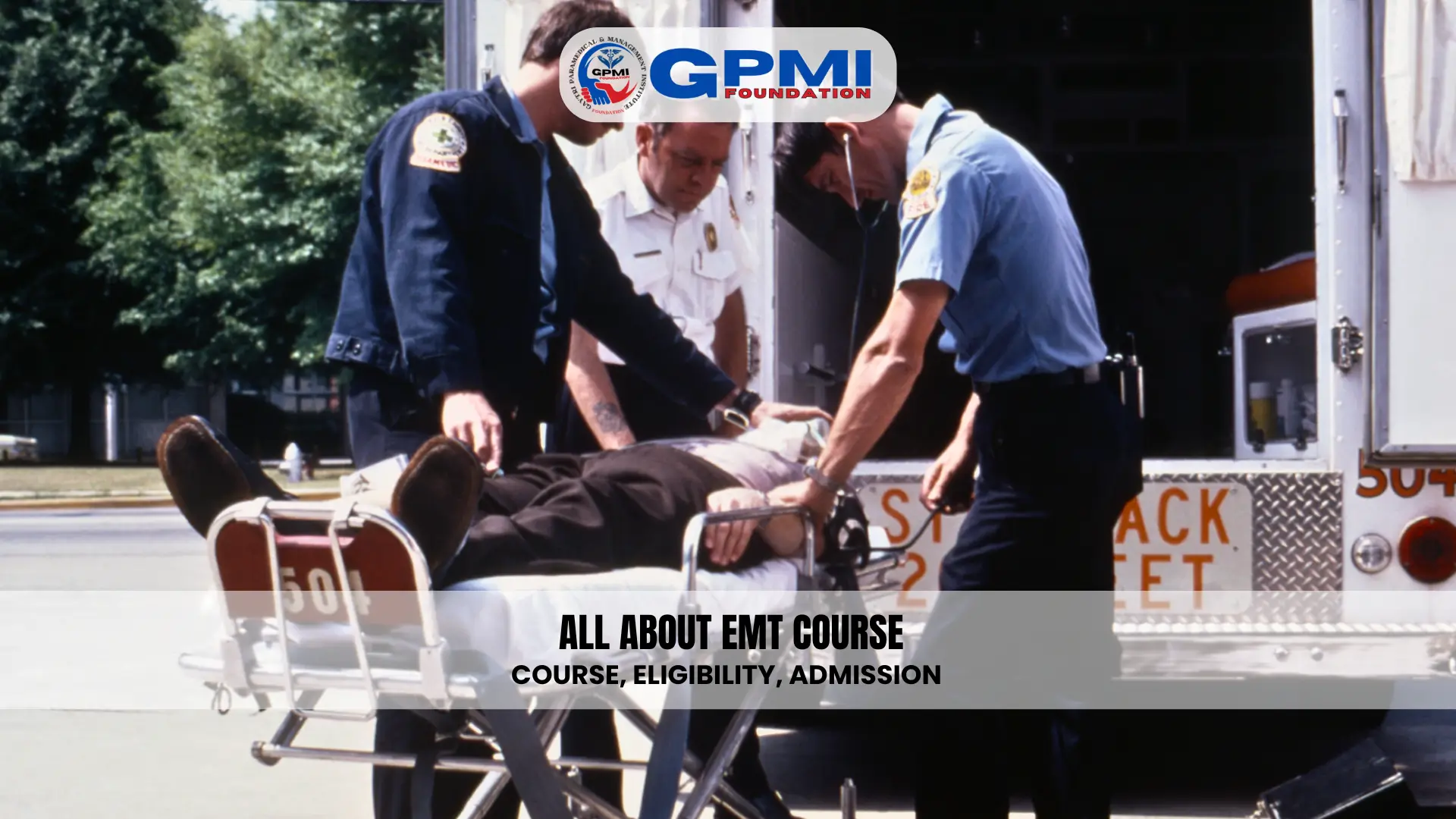Choosing the right career can be overwhelming, but if you’re looking for a fast-growing, high-impact profession, an EMT course is a smart choice. Emergency Medical Technicians (EMTs) play a crucial role in saving lives, responding to accidents, and providing urgent care.
With high job demand, quick certification, and opportunities for career growth, becoming an EMT offers both stability and purpose. In this blog, we’ll explore six compelling reasons why an EMT course is the best career choice.
Would you like details about the duration of the EMT course, eligibility, or career opportunities? Let’s dive into the details of Emergency Medical Technology.
Table of Contents
What is EMT?

An EMT (Emergency Medical Technician) is a trained healthcare professional who provides emergency medical care in critical situations. EMTs are often the first responders in medical emergencies, accidents, and disasters, offering life-saving care before a patient reaches the hospital.
An EMT Course trains individuals in handling medical emergencies, performing CPR, using defibrillators, managing trauma cases, and stabilizing patients during transport. After completing the course, EMTs can work in ambulances, hospitals, fire departments, and disaster response teams.
EMT Full form in medical
- In the medical field, EMT stands for Emergency Medical Technician.
- In construction & electrical Electrical Metallic Tubing
- In Technology & Business Enterprise Mobility Management
What Does An Emergency Medical Technician do?
Emergency Medical Technicians (EMTs) are first responders who provide emergency medical care in critical situations. Their primary role is to stabilize patients and transport them safely to hospitals.
Key Responsibilities of an EMT:
✔ Assess Patients – Quickly evaluate injuries or medical conditions.
✔ Perform CPR & First Aid – Provide life-saving interventions.
✔ Control Bleeding & Manage Trauma – Treat wounds, fractures, and burns.
✔ Administer Oxygen & Medications – Support breathing and stabilize vitals.
✔ Use Medical Equipment – Operate defibrillators, stretchers, and immobilization devices.
✔ Transport Patients – Ensure safe and efficient ambulance transport.
EMTs are crucial in saving lives before a patient reaches the hospital.
What is EMT Course?
An EMT Course (Emergency Medical Technician Course) is a specialized training program designed to equip individuals with the skills needed for emergency medical care. EMTs are first responders who assess patients, provide life-saving interventions, and stabilize them for transport to a hospital. The course covers CPR, trauma care, wound management, oxygen therapy, and handling medical equipment like defibrillators.

With high demand in ambulances, hospitals, fire departments, and disaster response teams, EMT training offers a fast-track entry into the healthcare field. It’s an ideal career for those who thrive in high-pressure situations and want to make a real difference in emergencies.
EMT Course Details…
Here’s a table with the essential details of the EMT Course (Emergency Medical Technician Course):
| Parameter | Details |
|---|---|
| Course Name | Emergency Medical Technician (EMT) Course |
| Course Duration | 6 months – 1 year |
| Eligibility | 10th or 12th pass (Science preferred) |
| Course Level | Certificate / Diploma |
| Skills Covered | CPR, Trauma Care, Wound Management, Patient Stabilization, Oxygen Therapy, Defibrillator Use |
| Career Opportunities | Ambulance Services, Hospitals, Fire Departments, Disaster Response Teams, Private Healthcare |
| Average EMT Salary | ₹2 – ₹4 LPA (varies by experience & location) |
| Certification | Provided after successful course completion |
EMT Course fees
The EMT Course fees in India vary based on the institute, course duration, and certification level. Here’s a general fee range:
| Course Type | Fee Range (INR) |
|---|---|
| Certificate Course (6 months) | ₹20,000 – ₹50,000 |
| Diploma Course (1 year) | ₹50,000 – ₹1,50,000 |
Government institutes may offer lower fees, while private institutes may charge more depending on facilities and accreditation. Some institutes also provide scholarships or installment payment options.
Different Types of EMT Courses
There are different types of EMT Courses based on the level of training and specialization. Here are the main types:
| Course Name | Duration | Details |
|---|---|---|
| Basic EMT (EMT-B) | 6 months – 1 year | Covers fundamental emergency medical care, CPR, trauma response, and patient transport. |
| Advanced EMT (EMT-A) | 1 year | Includes advanced airway management, IV therapy, and medication administration. |
| Paramedic (EMT-P) | 1.5 – 2 years | Highest level of EMT training with advanced life support (ALS), ECG interpretation, and emergency procedures. |
| EMT-Industrial & Workplace Safety | 6 months – 1 year | Designed for emergency medical response in industrial settings. |
| EMT-Disaster Response | Varies | Specialized training for handling mass casualty incidents and disaster relief. |
Admission to An EMT Course
EMT Course is open to candidates who have completed at least 10th grade from a recognized board. There are no entrance exams, and admission is based on a direct enrollment process.

The course is ideal for those interested in emergency medical services, offering practical training in handling critical and trauma cases. Upon completion, students can work in ambulances, hospitals, and emergency response teams.
Enroll today and start your journey as an Emergency Medical Technician! Here are different courses you can choose from.
EMT Certification Course
The EMT Certification Course (Emergency Medical Technician) is a short-term training program to prepare individuals to handle medical emergencies. EMTs are the first responders in critical situations, providing life-saving care before patients reach the hospital.
EMT Course Qualification
- Must have completed 10th or 12th grade (varies by institution).
- Basic knowledge of science and healthcare is preferred.
- Physically fit with good communication skills.
Duration
- Typically 6 months (may vary from 3 months to 1 year depending on the training program).
Syllabus
The course includes both theoretical knowledge and practical training in:
- Basic Life Support (BLS)
- First Aid and CPR
- Emergency Patient Assessment
- Medical and Trauma Emergencies
- Handling Stretchers & Ambulances
- Airway Management
- Infection Control & Safety Procedures
- Communication & Ethical Responsibilities
After completing the course, students can work in ambulance services, hospitals, disaster response teams, and emergency care units.
EMT Undergraduate Course
EMT Course Qualification
Candidates must have passed 10+2 (Science stream) from a recognized board. Some universities may require entrance exams or interviews.
Duration:
The undergraduate EMT course typically spans 3 years, leading to a Bachelor’s degree in Emergency Medical Technology or a related field.
Syllabus:
- Advanced Human Anatomy & Physiology
- Emergency Medical Systems & Protocols
- Pre-Hospital Trauma & Cardiac Care
- Pharmacology & Drug Administration
- Patient Transport & Evacuation Techniques
- Critical Care & Advanced Life Support (ALS)
- Disaster & Mass Casualty Management
- Ethics & Legal Aspects in Emergency Medicine
This course provides in-depth training, preparing students for roles in hospitals, ambulances, trauma centers, and disaster response teams.
EMT Post Graduate Course
The EMT Post Graduate Course is an advanced training program designed for healthcare professionals who want to enhance their skills in emergency medical services. This course goes beyond basic EMT training and prepares individuals for leadership roles, specialized emergency care, and critical patient management.
EMT Course Qualification
Bachelor’s degree in healthcare or related field (MBBS, B.Sc. Nursing, B.Voc. in Paramedical Sciences, etc.)
Duration:
1-2 years (varies by institution)
Key Syllabus for EMT Post Graduate Course
1. Advanced Emergency Medical Care
- Pre-hospital care protocols
- Triage and mass casualty management
- Advanced airway management techniques
- Critical trauma care
2. Emergency Pharmacology
- Drug classifications and administration
- IV fluid therapy and medication dosages
- Emergency drug interactions
3. Advanced Cardiac Life Support (ACLS)
- ECG interpretation
- Cardiac arrest management
- Defibrillation and pacing techniques
4. Pediatric & Neonatal Emergency Care
- Neonatal resuscitation protocols
- Pediatric trauma and emergency care
- Special considerations for infants
5. Respiratory and Pulmonary Emergencies
- Oxygen therapy and ventilation
- Advanced respiratory distress management
- Handling pulmonary embolisms and COPD crises
6. Trauma and Injury Management
- Head, spine, and musculoskeletal trauma
- Burn injury care
- Wound management and hemorrhage control
7. Disaster and Crisis Management
- Emergency response planning
- Natural disaster and pandemic response
- Scene safety and hazardous materials handling
8. Pre-Hospital Patient Transportation
- Ambulance operations and safety
- Air and water emergency evacuation
- Patient transfer protocols
9. Medical Ethics and Legal Considerations
- EMT professional standards
- Consent and confidentiality laws
- Medico-legal case handling
10. Research and Case Studies in Emergency Medicine
- Evidence-based EMT practices
- Case study analysis and critical thinking
- Innovations in emergency care
Graduates can work as advanced EMTs, paramedics, or emergency response coordinators in hospitals, ambulance services, and disaster relief organizations.
EMT Salary & Perks
The salary of an Emergency Medical Technician (EMT) varies based on experience, location, and employer. Here’s an overview:
1. Salary Range
- Entry-Level EMTs: ₹15,000 – ₹25,000 per month
- Mid-Level EMTs: ₹25,000 – ₹40,000 per month
- Experienced EMTs: ₹40,000+ per month
- International Salary: EMTs in countries like the USA, Canada, and the UK can earn between $35,000 – $50,000 per year.
2. Perks & Benefits
- Job Security: High demand in hospitals, ambulances, and disaster relief organizations.
- Growth Opportunities: With experience, EMTs can become paramedics, supervisors, or trainers.
- Additional Benefits: Health insurance, shift allowances, overtime pay, and government job opportunities.
Job Opportunities for an Emergency Medical Technician
Emergency Medical Technicians (EMTs) play a crucial role in healthcare, providing pre-hospital emergency care and transportation. Here are some career opportunities for EMTs:
- 1. Ambulance Services
- Work in private or government-run ambulance services.
- Provide life-saving assistance during emergencies.
- 2. Hospitals & Trauma Centers
- Assist in emergency departments and critical care units.
- Support doctors and nurses in stabilizing patients.
- 3. Fire Departments
- Work alongside firefighters in rescue operations.
- Provide emergency care at accident or disaster sites.
- 4. Disaster Response Teams
- Join organizations like the National Disaster Response Force (NDRF) or Red Cross.
- Offer medical aid in natural disasters and crises.
- 5. Air Ambulance Services
- Work in helicopters or aircraft for rapid emergency response.
- Assist in transporting critically ill patients.
- 6. Industrial & Corporate Safety
- Provide emergency medical support in factories, mines, and corporate offices.
- Ensure workplace safety and first aid readiness.
- 7. Event Medical Services
- Work at concerts, sports events, and large public gatherings.
- Provide on-site medical support for emergencies.
- 8. Teaching & Training
- Become an EMT instructor in training institutes.
- Train future EMT professionals in life-saving techniques.
- 9. Offshore & Remote Locations
- Work on ships, oil rigs, or remote construction sites.
- Provide emergency medical care in isolated areas.
- 10. Police & Military Services
- Join law enforcement or military medical teams.
- Provide medical support during operations and missions.
Future Scope
EMTs can upgrade their careers by pursuing advanced courses like Paramedic Training, B.Sc. in Emergency Medical Technology, or Critical Care Technician programs for better job prospects and higher salaries.
Why EMT is the Best Career Choice After 12th?
Choosing the right career after completing the 12th standard can be challenging. Many students aspire to enter the healthcare field but may not want to spend years in medical school.

If you are looking for a fast-track entry into the medical profession with good career prospects and job security, Emergency Medical Technician (EMT) is one of the best choices. EMTs play a vital role in emergency healthcare services, providing immediate care to patients in critical situations.
1. Quick Entry into the Healthcare Field
Most healthcare careers, such as MBBS or nursing, require several years of education before you can start working. However, an EMT course can be completed in just 6 months to 1 year, allowing you to start earning and gaining experience much faster.
This makes it an ideal option for students who want to enter the medical field quickly without spending years in higher education.
2. High Demand & Job Security
With increasing cases of medical emergencies like accidents, heart attacks, strokes, and disasters, the demand for EMTs is growing rapidly. Every hospital, ambulance service, and emergency response team needs trained EMTs. According to global trends, the demand for EMT professionals is expected to rise steadily in the coming years.
As an EMT, you can find job opportunities in:
- Hospitals (Emergency and Trauma Departments)
- Ambulance Services (Government & Private)
- Disaster Response Teams
- Rescue and Fire Services
- Air Ambulance Services
- Corporate Emergency Response Teams
Unlike many other careers, EMT professionals rarely face unemployment, as healthcare emergencies are constant.
3. Saves Lives & Makes a Difference
If you are someone who wants a career where you can help people and make a real difference, becoming an EMT is a great option. EMTs are the first responders in medical emergencies, ensuring that patients receive immediate life-saving care before reaching the hospital.
In critical situations such as:
- Accidents & Trauma Cases
- Heart Attacks & Strokes
- Respiratory Emergencies
- Poisoning & Drug Overdose Cases
- Fires, Earthquakes, and Other Disasters
Your quick response can mean the difference between life and death for a patient. This makes EMTs one of the most respected and rewarding professions in the healthcare industry.
4. Affordable Course with Good Salary
Unlike medical degrees that require lakhs in tuition fees, an EMT course is affordable, making it an excellent option for students from all backgrounds.
- Course Duration: 6 months – 1 year
- Course Fee: Much lower than traditional medical programs
- Starting Salary: ₹15,000 – ₹30,000 per month (varies based on location and experience)
- Career Growth: With experience, EMTs can become paramedics, supervisors, or work in specialized emergency care units
This means you can start earning faster without huge financial investment.
5. Diverse Career Opportunities
An EMT certification is just the beginning of an exciting career. With experience and additional certifications, you can advance into higher-paying medical roles, including:
- Paramedic – Advanced emergency responder with specialized medical training
- Emergency Room Assistant – Work in hospital emergency departments
- Disaster Relief Responder – Work with NGOs and government agencies in natural disasters
- Firefighter EMT – Work in rescue teams for fire and medical emergencies
- Air Ambulance EMT – Assist in critical patient transport via helicopters and planes
- EMS Instructor – Train future EMT professionals
- Further Studies – Become a nurse, physician assistant, or pursue other healthcare careers
This means an EMT career not only provides immediate job opportunities but also opens doors to long-term professional growth.
6. Gateway to Advanced Medical Careers
If you’re passionate about healthcare but not sure whether to commit to a long medical degree, EMT is a great starting point. Many professionals use EMT training as a stepping stone toward:
- Nursing (B.Sc. Nursing, GNM, ANM, etc.)
- Physician Assistant (PA) Programs
- Bachelor’s Degree in Paramedical Sciences
- Hospital Administration & Management
With EMT experience, you will have a strong advantage when applying for advanced healthcare programs.
If you want a fast-track entry into healthcare, a stable career, and the chance to save lives, becoming an Emergency Medical Technician (EMT) is the best choice after the 12th.
Conclusion
A career as an Emergency Medical Technician (EMT) offers a rewarding and impactful path for those passionate about saving lives. With job opportunities in hospitals, ambulances, fire departments, disaster response teams, and even international medical services,
EMTs play a vital role in emergency healthcare. The demand for skilled EMTs continues to grow, making it a stable and fulfilling career choice.
Whether you aim to work in patient transport, trauma care, or emergency response, the EMT course equips you with the essential skills to make a real difference in critical situations.
Frequently Asked Question
Here Are the Most Popular Frequently Asked Questions About the EMT Course – Training, Certification, Career Growth & More!”
Where do EMTs work?
EMTs work in ambulances, hospitals, fire departments, rescue squads, and emergency response teams.
Is being an EMT a good career choice?
Yes, EMTs are in high demand, and the profession offers career growth in paramedicine, firefighting, and emergency healthcare
What is the difference between an EMT and a paramedic?
EMTs provide basic life support (BLS), while paramedics offer advanced life support (ALS), including IV therapy and medication administration.
Who is eligible for an EMT Course?
Most EMT courses require a 10th or 12th-grade pass, preferably with a science background. Some programs have age and physical fitness requirements.
What skills do I need to be a successful EMT?
Quick thinking, physical stamina, communication skills, and the ability to stay calm under pressure are essential for EMTs.
Can I become a paramedic after completing an EMT Course?
Yes, EMTs can pursue advanced training to become paramedics.
What is the highest EMT salary?
Entry-Level (0-2 years):- ₹15,000 – ₹30,000 per month
Mid-Level (2-5 years):- ₹25,000 – ₹40,000 per month
Experienced (5+ years):-₹40,000 – ₹70,000 per month
Advanced EMT / Paramedic:- ₹50,000 – ₹80,000 per month
Air Ambulance EMT:- ₹80,000 – ₹1,50,000 per month
Industrial Safety EMT (Oil & Gas, Factories):- ₹60,000 – ₹1,20,000
I have passed my 12th in Arts, can I apply to be an EMT?
Yes, you can apply for an Emergency Medical Technician (EMT) course after passing 12th in Arts, but your options may be limited.
Most EMT courses prefer candidates with a Science background (Physics, Chemistry, and Biology). However, some institutes accept Arts and Commerce students for basic EMT certification programs, provided they meet other eligibility criteria like age and physical fitness.
Does NEET Score Matter for EMT Admission?
No, NEET score is not required for admission to an Emergency Medical Technician (EMT) course. Most EMT courses have direct admission based on eligibility criteria, which typically require a 10th or 12th pass qualification.
Some institutes may conduct interviews or entrance tests, but NEET is not a requirement.







